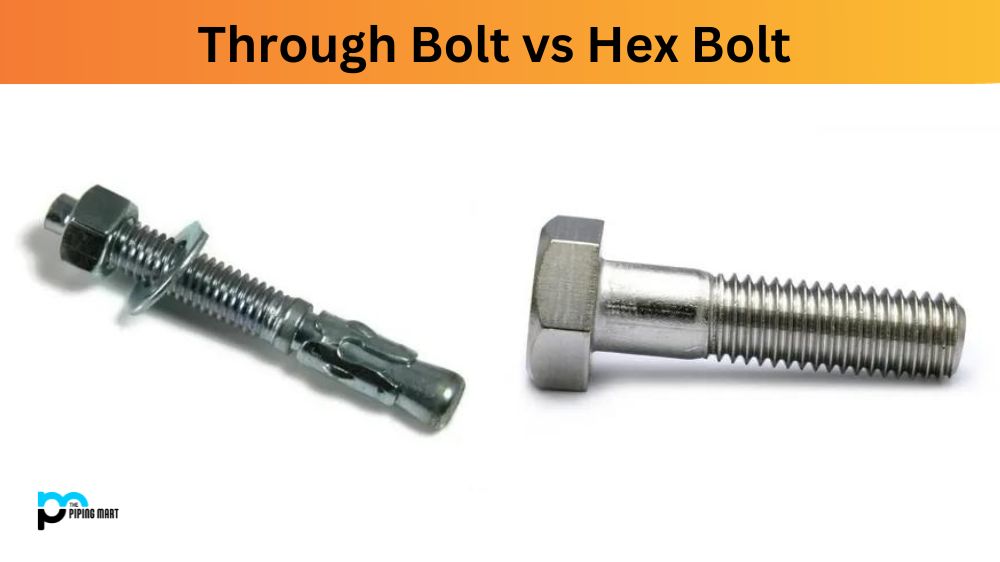A bolt is an essential tool in construction and DIY projects. It is a type of fastener that holds two or more surfaces together. While there are different kinds of bolts, Through bolts and Hex bolts are two of the most commonly used ones. While these two types of bolts may look the same, there are crucial differences that every builder and DIY enthusiast should know. This blog will explore the difference between through and hex bolts.
What is Through Bolt?
A through bolt is a fastener used to secure two objects together. It typically consists of a threaded, cylindrical shaft with an unthreaded collar and two nuts. The bolt passes through a pre-drilled hole in each object, and the nut is tightened on either side to create a strong connection between the two pieces. Through bolts are popularly used in construction applications but can also be found in other industries requiring reliable connections.
What is Hex Bolt?
A hex bolt is a type of fastener, also known as a hex head cap screw, typically used in construction and engineering projects. It features an externally threaded shaft with six-sided heads for easy gripping and tightening. It is commonly made from corrosion-resistant steel, stainless steel or alloy materials to ensure longevity under various environmental conditions.
Difference Between Through Bolt and hex Bolt
Structure of the Bolt:
Through bolts have a thread running right through the bolt to the other end, and they are usually made with stainless steel or zinc-plated materials. Hex bolts have a threaded hexagonal head and a threaded shank that bolts onto a surface. Through bolts have no threads on their top, but hex bolts have threads on their entire body.
Usage:
Through bolts are used to securely attach heavy equipment to solid surfaces, such as walls, floors, or concrete structures. They are usually used for load-bearing applications, as they can withstand heavier loads than other bolt types. Hex bolts are mainly used for non-load-bearing applications where they are used to hold two or more surfaces or machines in place.
Installation Process:
Through bolts, they have a relatively simple installation process. They are inserted through a pre-drilled hole, and a thread on the end of the bolt, furthest from the head, is drilled into the concrete. Once it is secured, the installation is complete. The installation process for hex bolts is more complicated, requiring both a nut and bolt to be properly attached to the surface. Hex bolts need an excellent clamp force to properly secure the nut and bolt.
Resistance to Tension and Shearing forces:
Through bolts, it can resist both shear and tension forces. The forces are distributed throughout the entire length of the bolt, making it ideal for supporting high weights. They are also highly resistant to impact loads. Hex bolts are better suited for resisting tensile loads because they spread the load across the bolt’s shank, resulting in a more even distribution. Hex bolts are susceptible to shear loading, which tends to snap the bolt.
Cost:
Through bolts are generally more expensive than hex bolts. This is mainly because they require more material and a more complicated manufacturing process. Hex bolts are less expensive because they are relatively simple and quick to manufacture.
Conclusion:
In conclusion, while Through bolts and Hex bolts may look the same, there are crucial differences that every builder and DIY enthusiast should know. Through bolts are designed for load-bearing applications and are expensive, but they can handle heavier loads and resist shear and tension forces. In contrast, hex bolts are affordable and ideal for holding two or more surfaces in place. Hex bolts are more suitable for handling tensile loads and are susceptible to shear loading. Understanding the differences between the two and selecting the right type for your project is crucial to achieving a successful outcome.

Pipingmart is a B2B portal that specializes in metal, industrial and piping items. Additionally, we share the latest information and information about materials, products and various types of grades to assist businesses that are involved in this business.




